While the state of New Jersey is known for its bustling cities and iconic coastline, it also boasts a diverse range of flora and fauna. However, not all plants found in the state are harmless. In fact, there are several dangerous plants that residents and visitors alike should be aware of to avoid potential harm or health risks. It’s important to know how to identify these plants and take necessary precautions if you come into contact with them while exploring the natural beauty of New Jersey.
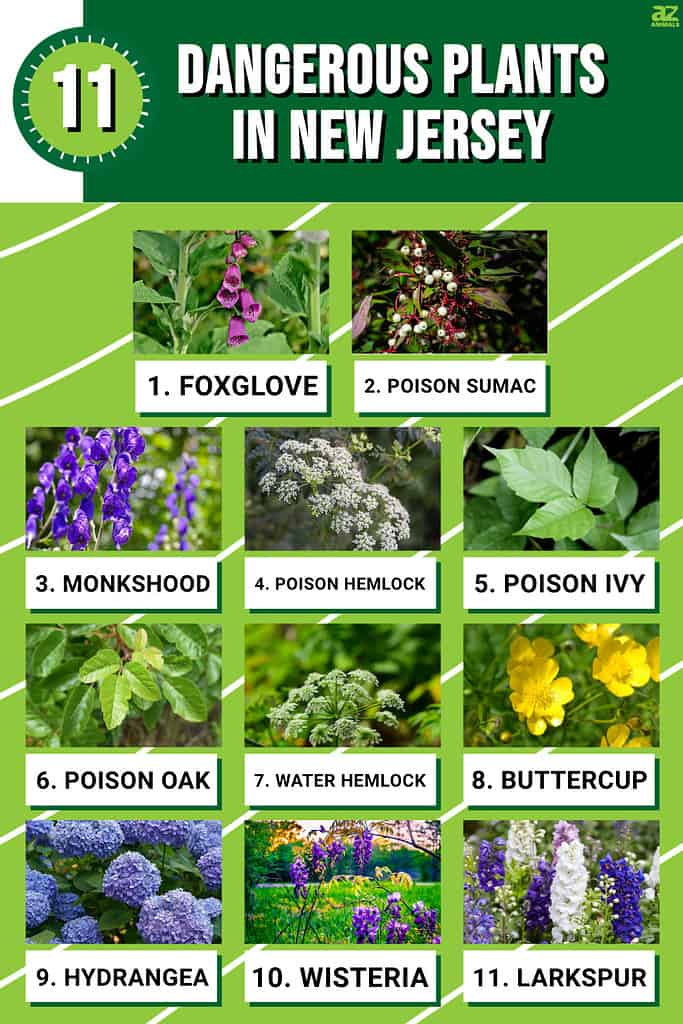
Dangerous Plants That Grow in New Jersey
The danger posed by certain plants to humans or animals can be attributed to a variety of factors. Some plants may contain toxic chemicals that can cause harm if ingested, touched, or inhaled. Others may have sharp thorns or spines that can puncture the skin and cause injury. Additionally, some plants may release allergens into the air, causing respiratory issues for those who are sensitive. In New Jersey specifically, there are several dangerous plants that residents should be aware of. We will discuss them in detail below.
1. Foxglove

The foxglove contains a potent toxin called digitalis that can be dangerous if ingested by humans or animals.
©iStock.com/Elmar Langle
Foxglove is a common plant found in New Jersey and other parts of the world. It typically grows in shaded areas, such as forests or along the edges of fields. The plant can grow up to 6 feet tall and produce beautiful bell-shaped flowers ranging from pink to purple.
While foxglove may look harmless, it contains a potent toxin called digitalis that can be dangerous if ingested by humans or animals. Digitalis affects the heart and can cause irregular heartbeat, nausea, vomiting, and even death.
It’s important to note that many medications used today are derived from digitalis compounds found in foxglove. However, these medications are carefully controlled doses prescribed by doctors and should never be self-administered.
Foxglove is a dangerous plant in New Jersey. If you come across foxglove while out on a hike or exploring nature, admire its beauty but avoid touching or consuming any part of the plant. Teaching children about the dangers of wild plants like foxglove is also crucial for their safety when spending time outdoors.
2. Poison Sumac
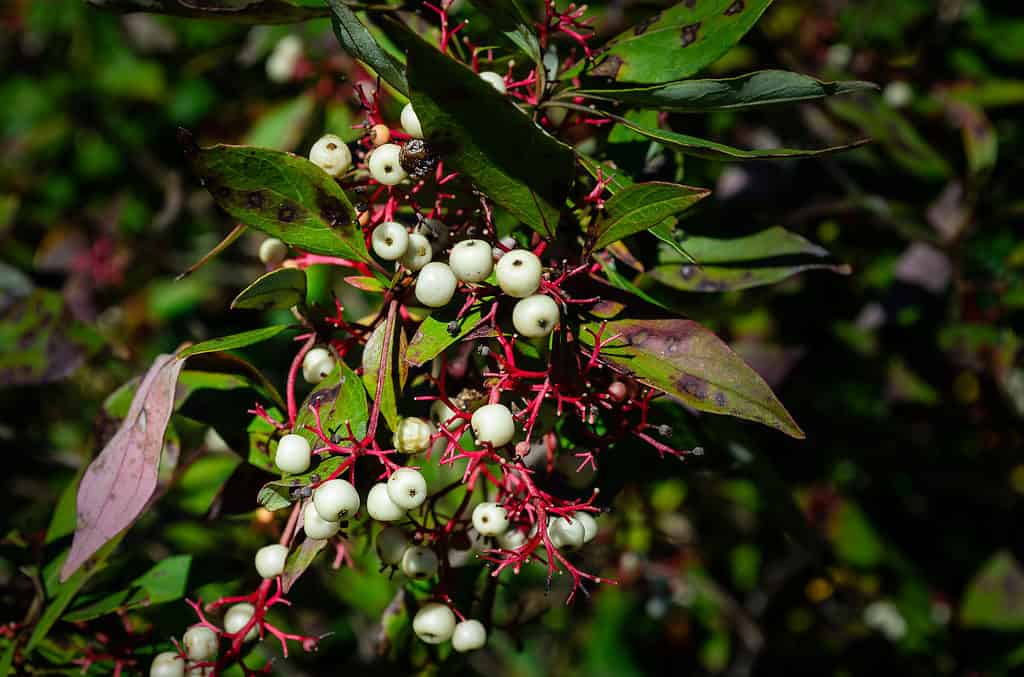
When poison sumac’s urushiol oils come into contact with human skin, they instantly trigger an allergic reaction.
©iStock.com/Grb
Poison sumac is a highly toxic plant that can cause severe allergic reactions in humans and animals. It is important to be able to identify this plant, as it grows abundantly in New Jersey and other areas of the United States. Poison sumac typically grows in wetland areas such as swamps, bogs, and marshes. The leaves of the poison sumac are long and pointed with smooth edges, and they grow on branches that have red stems. The leaves change color according to the seasons. They are green during spring and summer, then yellow or orange during fall, finally turning brown during winter.
What makes poison sumac dangerous are its urushiol oils which come from its stem bark, twigs, fruit, roots, sap, or even fallen leaves which can remain active for years after falling off their host tree. When these oils come into contact with human skin (or animal fur), they immediately trigger an allergic reaction, causing itching rashes along with painful blisters that may appear within hours or days, depending on each individual’s immune system response.
In addition to skin irritation, symptoms like swelling around eyelids and mouth area (if accidentally touched) are common. Inhaling smoke from burning poison sumac might also lead to respiratory problems like coughing due to irritant effects on the lungs’ airways. This means one should never burn poisonous plants as they could spread toxic particles throughout your surrounding environment.
3. Monkshood
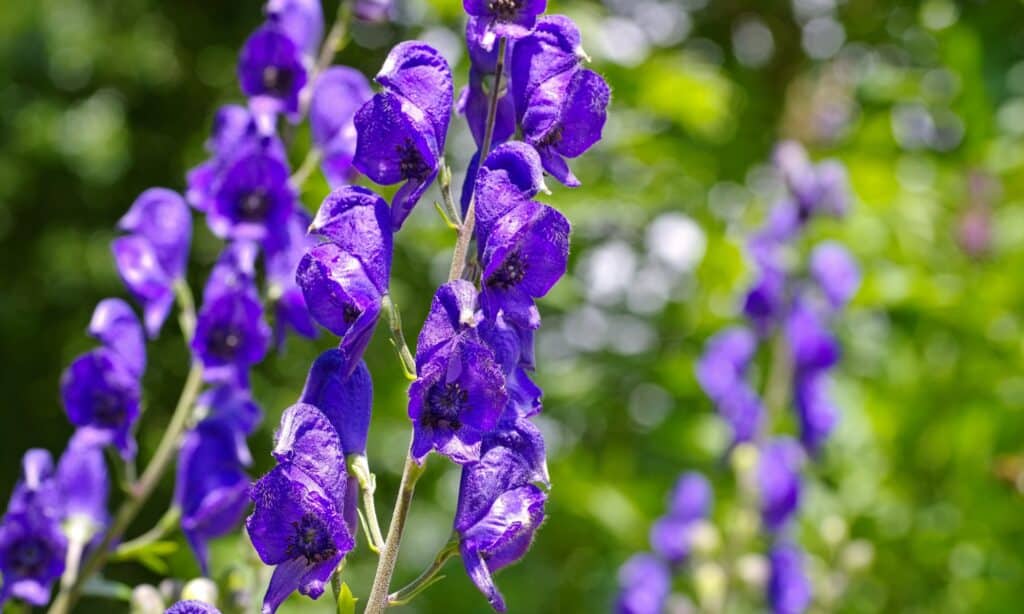
Contact with any part of the monkshood plant (flower petals included) should be avoided at all costs.
©iStock.com/LianeM
Monkshood, also known as Aconitum or wolf’s bane, is a highly poisonous plant that can be found growing in various parts of New Jersey. It is characterized by its tall spikes of blue or purple flowers and distinctive hood-like shape.
This deadly plant typically blooms during the late summer months and can grow up to 6 feet tall. It prefers damp soil conditions and can often be found along riverbanks, in meadows, and in wooded areas.
While beautiful to look at, monkshood contains potent toxins that can prove fatal if ingested or even touched without proper protection. The toxin affects the nervous system causing numbness, tingling sensations, weakness, and nausea within minutes after exposure. If left untreated, it may cause respiratory failure leading to death.
It is important to exercise extreme caution when handling this dangerous plant as its poison has been used for centuries as an effective method of killing both humans and animals alike. Contact with any part of the plant (flower petals included) should be avoided at all costs. Gloves must always be worn when handling or removing it from garden beds due to the danger involved.
4. Poison Hemlock

Identifying poison hemlock can be challenging since it resembles several other harmless plants.
©iStock.com/gabrielabertolini
Poison hemlock is a highly toxic plant that can pose serious risks to both humans and animals. It is one of the most dangerous plants in New Jersey. It belongs to the carrot family and grows in moist environments such as fields, meadows, ditches, and along roadsides. The plant typically reaches heights of 3-8 feet tall, with white flowers clustered at the top of stems during late spring or early summer.
Identifying poison hemlock can be challenging since it resembles several other harmless plants such as wild carrots, Queen Anne’s lace, parsley, or fennel. However, there are some distinguishing characteristics, including purple splotches on the stem (especially near where leaves attach) and smooth hairless stems with a waxy sheen when young but may become hairy as they mature.
The danger posed by poison hemlock lies in its ability to produce an array of toxins known as coniine that affects the nervous system leading to paralysis and eventual death if left untreated. All parts of this deadly weed contain these toxins, but the highest concentrations are found in seeds, followed by leaves, then finally, roots.
If you suspect poisoning from contact with poison hemlock, seek immediate medical attention!
5. Poison Ivy
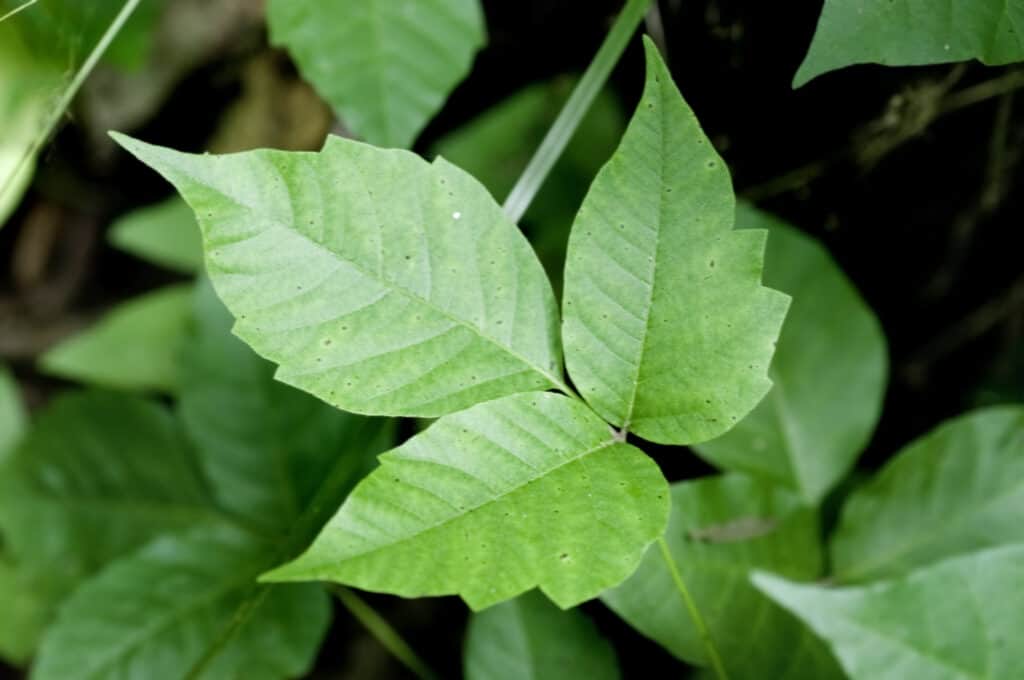
Poison ivy has compound leaves consisting of three individual leaflets.
©Tim Mainiero/Shutterstock.com
Poison ivy is a commonly found dangerous plant in New Jersey and can be identified by its three shiny, pointed leaves. It typically grows as a vine or shrub and can be seen climbing up trees, fences, or walls. The plant thrives in wooded areas, fields, and gardens across the state.
The danger posed by poison ivy comes from an oil present on the surface of its leaves called urushiol. When someone comes into contact with this oil through direct touch or indirectly through contaminated objects such as clothing or equipment, they may develop a rash that can cause itching, swelling, and blistering skin. In severe cases, it could lead to difficulty breathing if the smoke from burning plants containing urushiol is inhaled.
It’s important to note that not everyone develops a reaction when exposed to poison ivy, but avoiding exposure altogether is crucial for those who do. Protective clothing such as long sleeves and pants should be worn when venturing outdoors near known areas of poison ivy growth while also taking care not to touch any part of the plant directly.
6. Poison Oak

The danger posed by poison oak lies in the urushiol oil on its stems, leaves, roots, and even its sap.
©ShutterstockProfessional/Shutterstock.com
Poison oak is a common plant found in the eastern and western regions of North America, including New Jersey. It typically grows as a shrub or vine with leaves that are similar in appearance to those of an oak tree, hence its name. The leaves of poison oak are usually arranged in clusters of three and have a distinctive shape that resembles the tips of fingers.
The plant can grow up to 6 feet tall and blooms between May and July, producing small yellow-green flowers followed by white berries. Poison oak thrives in moist areas such as woods, fields, riverbanks, and along roadsides.
The danger posed by poison oak lies in the urushiol oil present on its stems, leaves, roots, and even its sap. When this oil comes into contact with the skin, it causes itching, redness, and blistering, which can last for several weeks if left untreated. In severe cases, exposure to urushiol oil can also cause fever or difficulty breathing, requiring medical attention.
It’s important to note that not everyone will be affected by poison oak since sensitivity varies from person to person. However, caution should still be exercised when coming into contact with plants growing wild because the consequences could be severe for some individuals.
Animals can also suffer from poisoning due to their fur rubbing against the poisonous plant, causing them itchiness or feeling uncomfortable, leading them to scratch themselves intensely, making sores on their skin which could lead to infections or further complications if left untreated.
7. Water Hemlock
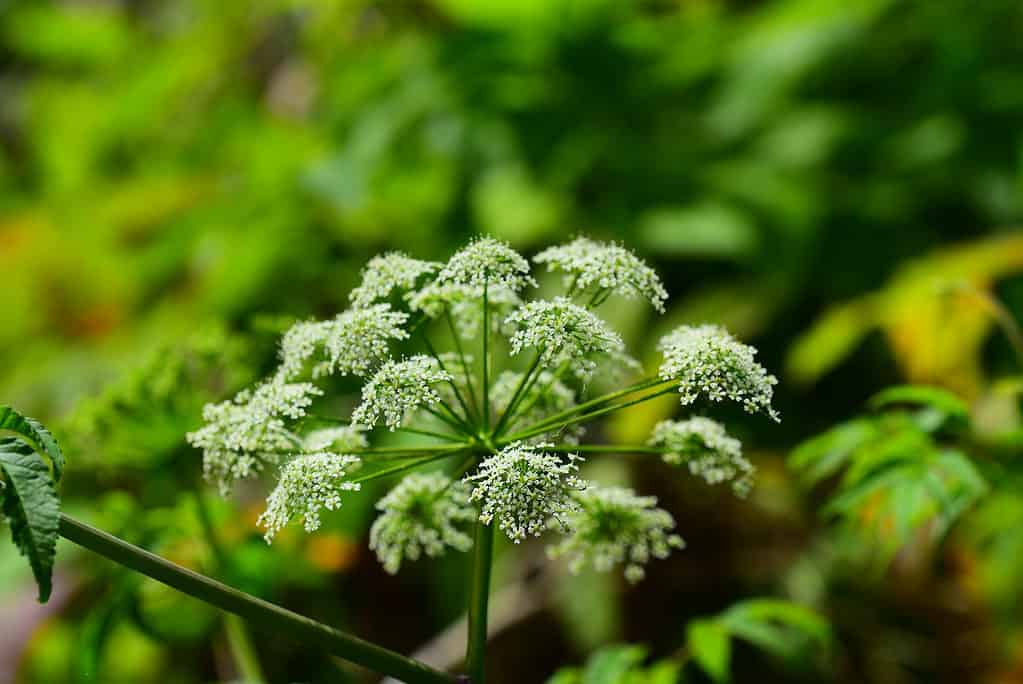
The toxins in water hemlock can cause seizures, respiratory failure, and death within hours of ingestion.
©iStock.com/cturtletrax
Water hemlock is a highly poisonous plant that can be found growing in New Jersey. The plant typically grows near bodies of water, such as streams, marshes, or wetlands, but it can also be found in fields or meadows.
One of the most dangerous aspects of water hemlock is its resemblance to edible plants such as wild carrots or parsnips. It has long stalks with small white flowers grouped together in umbels. Its leaves are divided into three leaflets that may look similar to those on dill or parsley plants. This similarity makes it easy for people to mistake water hemlock for an edible plant and accidentally ingest it.
The toxins present in water hemlock affect the central nervous system and can cause seizures, respiratory failure, and death within hours after ingestion. Ingesting even a small amount of the plant is extremely dangerous. Just a few bites from its root can lead to severe poisoning.
It’s important to note that animals such as cows or horses have also been known to die after grazing on this deadly weed. Therefore farmers should always ensure that their livestock does not have access to areas where this weed thrives.
8. Buttercup
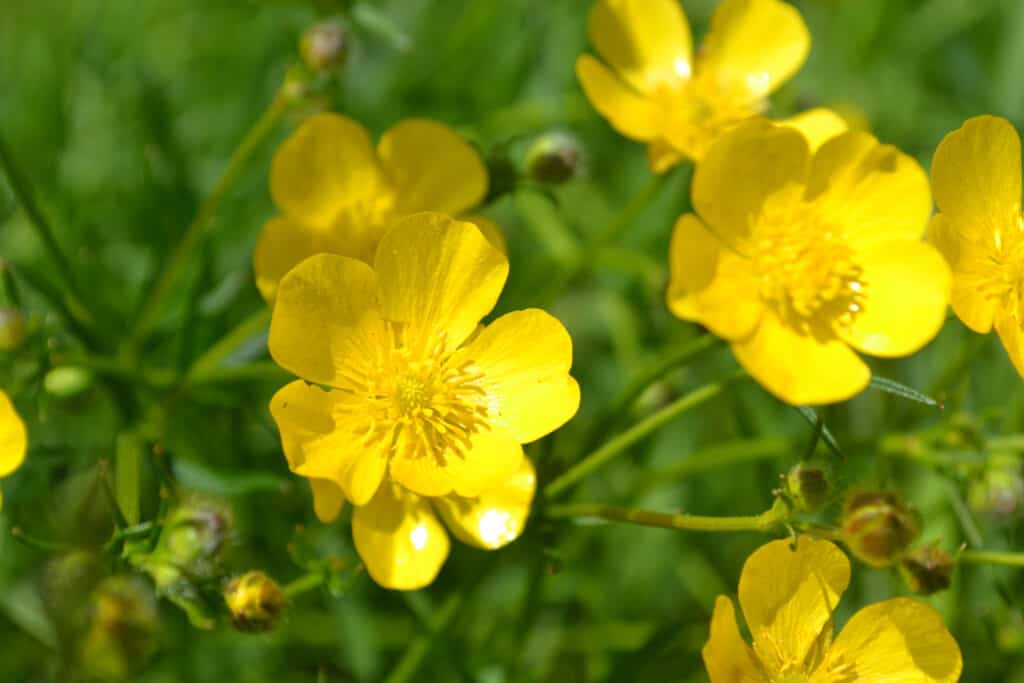
Buttercups have a horrible bitter taste, so pets and livestock are unlikely to eat them.
©Juli_Kom/Shutterstock.com
Buttercup is a common wildflower that can be found in many parts of New Jersey. It typically grows in open fields, along roadsides, and in meadows during the spring and early summer months. The plant has bright yellow petals and glossy green leaves with distinctive lobes that give it a unique appearance.
Although buttercup may seem harmless, they can be quite dangerous to humans and animals if ingested. The plant contains a toxic substance called ranunculin which, when crushed or chewed, releases an irritant oil that can cause skin irritation, blistering, swelling, and redness.
Ingesting any part of the buttercup plant can also lead to serious health problems such as vomiting, diarrhea, stomach pain, and even paralysis in some cases. As such, it is important for people to exercise caution around this particular species of wildflower. The good news is that buttercups have a horrible bitter taste, so pets and livestock are unlikely to munch on them.
9. Hydrangea

Hydrangea are beautiful flowers but are toxic to animals due to cyanogenic glycosides in the plant.
©George Cade/Shutterstock.com
Hydrangea is a popular ornamental plant that is commonly found in gardens and parks across New Jersey. It is a deciduous shrub that can grow up to 6 feet tall and has large, showy flower heads that range in color from white to pink, blue, or purple.
While hydrangea may look beautiful and harmless, it can actually pose a significant risk to animals such as dogs and cats if ingested. This is because the plant contains cyanogenic glycosides, which are toxic when consumed. When an animal eats parts of the plant — especially the leaves or flowers — these toxins break down into hydrogen cyanide, which can cause symptoms ranging from mild gastrointestinal upset to severe respiratory distress or even death.
Despite this danger, humans are not typically at risk from hydrangea poisoning as they would have to consume large amounts of the plant for any harmful effects to occur. However, it’s important for pet owners and anyone working with animals (such as farmers) to be aware of the potential risks associated with this common garden staple.
10. Wisteria
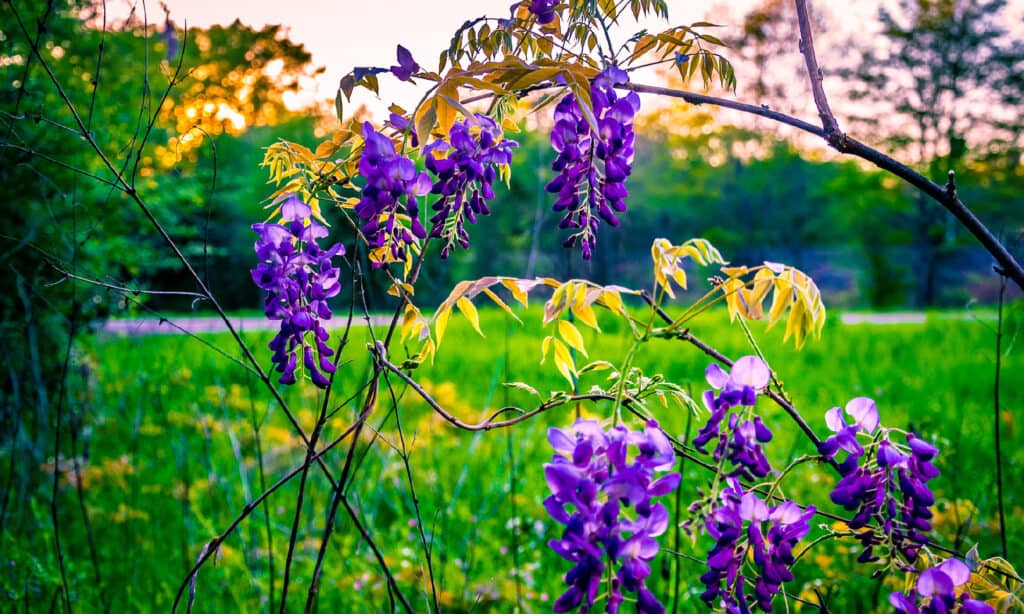
Wisteria is a vining plant that is toxic to both humans and animals.
©iStock.com/Steve Shubert
Wisteria is a woody vine that can grow up to 30 feet long, with fragrant purple or white flowers that bloom in the spring. It typically grows on trellises, walls, and fences in gardens and parks across New Jersey. While wisteria may not be deadly to humans or animals, it can still pose a danger if ingested or handled improperly. The plant contains glycosides, which can cause nausea, vomiting, diarrhea, and dizziness if consumed in large quantities by humans or pets. Additionally, touching or handling the sap from the vines can cause skin irritation for some individuals. Therefore caution should be exercised when coming into contact with this beautiful yet potentially harmful plant species.
11. Larkspur

Ingestion of hay or water sources contaminated by larkspur can result in poisoning.
©iStock.com/AndreaAstes
Larkspur is a tall, elegant plant that can grow up to 6 feet in height. It typically blooms in mid-summer and can be found growing wild throughout the state of New Jersey. Larkspur is known for its beautiful blue-purple flowers that are arranged in long spikes along the stem. Many people who live in New Jersey don’t know about this dangerous plant.
While larkspur may be aesthetically pleasing, it poses a significant danger to both humans and animals. The entire plant contains toxic alkaloids that are highly poisonous when ingested. These toxins can cause severe symptoms such as muscle weakness, difficulty breathing, paralysis, and even death.
It’s important to note that larkspur toxicity is not limited to direct contact with the plant itself. Ingestion of contaminated hay or water sources can also result in poisoning. As such, it’s crucial for farmers and livestock owners to carefully monitor their pastures and ensure there are no traces of larkspur present.
Summary of 11 Dangerous Plants That Grow in New Jersey
Here’s a recap of the 11 deadly plants found in New Jersey that we took a look at.
| Rank | Plant |
|---|---|
| 1 | Foxglove |
| 2 | Poison Sumac |
| 3 | Monkshood |
| 4 | Poison Hemlock |
| 5 | Poison Ivy |
| 6 | Poison Oak |
| 7 | Water Hemlock |
| 8 | Buttercup |
| 9 | Hydrangea |
| 10 | Wisteria |
| 11 | Larkspur |
Thank you for reading! Have some feedback for us? Contact the AZ Animals editorial team.








